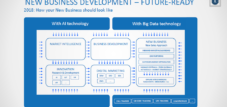The sales paradox-forget the Sales Funnel: The Customer Journey is dead-despite AI, Automation and CRM!
Xpert pre-release
Language selection 📢
Published on: April 6, 2025 / update from: April 6, 2025 - Author: Konrad Wolfenstein

The sales paradox-forget the Sales Funnel: The Customer Journey is dead-despite AI, Automation and CRM! - Image: Xpert.digital
Personal branding in sales: the key to success in an unpredictable world
The decryption of the modern sales puzzle
The world of sales has changed dramatically in recent years. This is particularly responsible for the rapid progress of new technologies. Artificial intelligence (AI), automation and customized relation hip management systems (CRM) have developed into indispensable tools. Originally, it was assumed that these technologies would make the sales results much better predictable. CRM systems promised a comprehensive overview of the customer, automation should optimize processes and give AI-based analyzes deep insights into customer behavior.
The sales paradox: why customers are becoming increasingly unpredictable and what this means for the future of sales
But reality looks different. Despite all this technological advances, the behavior of customers in B2B sales seems to become increasingly difficult to assess. This discrepancy between the original expectation of increased predictability and the actual observation of increasing customer unchangeability is the core problem of modern sales paradox.
The initial enthusiasm for the potential of technology to simplify sales processes and predict sales results more precisely has given way to the knowledge that the buying behavior of customers is subject to more complex dynamics. The introduction of CRM and automation solutions aimed at rationalizing processes and gaining a clearer perspective on the customer. However, the increasing availability of information for customers has fundamentally changed the balance of power and the decision -making processes, which, despite technological advances, leads to less predictable behavior.
The term “paradox” indicates a contradictory situation. It seems that the more tools and data are available, the more difficult it is to understand and predict customer actions. This indicates that the relationship between technology and customer behavior is not linear and other factors play a role.
This article aims to comprehensively analyze the multi -layered phenomenon of sales paradox. We will examine the causes of this growing unpredictability, examine the effects on the customer journey and traditional sales processes, critically evaluate the role of technology and human interaction, emphasize the importance of personnel branding and attitude in modern sales, develop effective strategies for sales teams in this environment, illuminate the development of sales KPIs and finally the changing requirements on sales employees And identify the decisive skills for the future.
Suitable for:
- What makes good business development and what is the difference? – It includes more than just sales and marketing
The changing customer behavior: why the predictability decreases
Current studies and reports confirm the thesis of an increasingly unpredictable customer behavior in sales. A report by the Kearney Consumer Institute (KCI) emphasizes paradoxical tensions among consumers who make their behavior puzzling for many sellers. The study identifies three central areas of tension that contribute to this unpredictability:
Options and overwhelming
Customers expect products that are tailored to their individual needs, they feel overwhelmed in many product categories from the sheer number of options.
Couration and control
Most customers are happy to make their own decisions, but at the same time need a certain curation to overlook the large number of options.
Facts and feelings
Customers want to carry out their own research and trust themselves more than brands, but only have a limited time and energy for it.
Why customer decisions are becoming increasingly complex and how companies should react to it
Additional statistics illustrate the increasing demands of consumers. 76 % of consumers expect a consistent experience across all channels, and 84 % expect immediate answers to sales or marketing issues. In addition, 61 % of consumers state that their service expectations have increased compared to the previous year. These numbers indicate a changed customer behavior that is characterized by higher expectations of speed, consistency and personalization, which makes it difficult to predict their actions. McKinsey & Company also emphasizes the rapidly changing beliefs and behaviors of consumers and how companies need deep insights into these changes in order to keep step and possibly even influence them. The Covid 19 crisis, for example, has forced many consumers to change their habits, which in turn influenced their beliefs about everyday activities.
Paradoxically, the abundance of choices often leads to an “analysis paralysis” and decision-making, which affects the conversion rates in sales directly. Although a wide range of options initially appears attractive, it can increase the cognitive burden on the decision -makers and lead to uncertainty or even to terminate the purchase process. This development is in direct contradiction to the traditional sales acceptance that a larger variety of products automatically leads to higher sales figures.
The increasing importance of self -information for customers means that they have often already made a large part of their purchase decision before they even get in touch with a sales employee. They use the Internet and other channels to find out comprehensive information and to define their needs. As a result, the traditional sales tactics based on the initial information transfer losing relevance. Sales interactions must now focus on deeper promises of value and address specific needs that the customer has already identified through his own research.
Overall, it can be found that power has shifted from information to the customer due to the easy accessibility of information, which forces sales teams to switch from a product -centered to a customer -centered approach. Customers today expect personalized experiences, immediate reactions and solutions that are tailored to their specific, often well -researched needs. Sales teams who do not recognize this shift and do not adapt to it will probably have difficulty being successful.
Suitable for:
- Beware of the trap: Digitalization is not a playground - ads, DTC sales and the harsh reality of performance marketing
The deconstruction of the customer journey in the age of self -information
The Customer Journey has changed fundamentally in recent years. It is no longer to be understood as a linear path, but rather like a complex network of interactions about a variety of online and offline channels. The increase in available devices, sales channels, social media and advertising opportunities has led to customers developing their own way to make a purchase. This non-linear character of the Customer Journey, in which customers switch between different touchpoints and devices before making a final decision, makes it difficult to predict and determine the exact path of a customer at which he comes into contact with sales.
This development has a significant impact on traditional, linear sales function. The classic sales funnel, with its clearly defined phases from lead generation to the end, can hardly map the complex and often circular ways of modern customers. Customers may return to previous phases, search for additional information or need further validation after a first contact. This requires the adaptation of flexible models that focus on continuous commitment and customer experience over the entire life cycle instead of selling a purely linear progression. An example of such an adaptive model is the Flywheel concept, which emphasizes the networking of marketing, sales and customer service in order to promote sustainable growth.
The modern B2B customer trip is strongly shaped by research and validation by digital channels. Customers often spend a long time in “research mode”, in which they search for information, read reviews online and find out about various options before interacting with a sales employee. This phase of self -information is crucial for your decision -making. Companies must therefore ensure that they are present in these digital channels and provide valuable, informative content that support customers in their different phases of decision -making.
The role of sales is therefore moving from the primary source of information to an advisory partner who helps the customer to process the information already collected and find the best solution for him. In this context, the seamless integration of sales and marketing activities is essential in order to ensure a consistent brand experience across all touchpoints and to optimally accompany customers on their individual trip.
The double -edged sword: AI and automation in sales
The implementation of AI and automation tools has increased significantly in various sales processes. For example, AI is used for lead generation and qualification by analyzing large amounts of data in order to identify potential customers. Automation helps personalize customer speeches, sending follow-up emails and the update of CRM systems, which relieves sales employees from repetitive tasks. In addition, AI-based analyzes for sales forecasts and identification of patterns in customer behavior are used. Even in the area of sales coaching, AI platforms are used that offer personalized feedback and training suggestions based on the analysis of sales talks.
Although technology has the potential to improve the understanding and influence of customer behavior, their possibilities are limited. AI can process huge amounts of data and recognize patterns, but it lacks emotional intelligence and the differentiated understanding of human interactions. The paradoxical tensions in customer behavior, such as those between the desire for options and the overwhelming, by too many options or between facts and feelings, are often difficult to grasp by purely rational algorithms. Excessive dependence on AI and automation can also lead to ethical concerns regarding transparency, bias in algorithms and data protection.
The human interaction therefore remains indispensable in AI-based sales. The human component is particularly crucial in complex negotiations, building trust and dealing with the emotional needs of the customer, especially in high-priced B2B sales. The future of sales lies primarily in a hybrid approach in which AI increases efficiency and provides valuable insights, while sales professionals use their human abilities to build strong relationships and develop a deep understanding of the individual needs of their customers.
Suitable for:
🎯🎯🎯 Benefit from Xpert.Digital's extensive, fivefold expertise in a comprehensive service package | R&D, XR, PR & SEM

AI & XR 3D Rendering Machine: Fivefold expertise from Xpert.Digital in a comprehensive service package, R&D XR, PR & SEM - Image: Xpert.Digital
Xpert.Digital has in-depth knowledge of various industries. This allows us to develop tailor-made strategies that are tailored precisely to the requirements and challenges of your specific market segment. By continually analyzing market trends and following industry developments, we can act with foresight and offer innovative solutions. Through the combination of experience and knowledge, we generate added value and give our customers a decisive competitive advantage.
More about it here:
Personal branding in B2B: How to strengthen trust and credibility
Beyond automation: the lasting power of human interaction
In the B2B area, where trust, authority and long-term relationships are of crucial importance, “Personal Branding” plays an important role. It enables sales professionals to humanize their companies by presenting individual expertise, values and thought leadership. A strong personal branding not only differentiates from competitors, but also establishes credibility and authenticity, which is well received by other companies. Authenticity, transparency and consistency are crucial to establish permanent connections that benefit both the individual and the company.
The “attitude” (Attitude) in modern sales is equally significant. A positive and proactive way of thinking is not only desirable, but essential. It helps to build stronger relationships, to get in touch with customers and ultimately achieve more degrees. Self -perception, emotional intelligence and the ability to deal with setbacks are key elements for success in sales.
To build strong personal branding, sales professionals should choose a platform on which you can reach your target group, for example LinkedIn, and create a professional profile there. The definition of one's own niche and expertise is just as important as the consistent parts of valuable content, be it through blog posts, social media activities or participation in industry events. Authenticity plays a crucial role in this; It is about strengthening your own values and passions and reflecting them in communication. Maintaining personal interactions and building a professional network are other important strategies.
In order to cultivate a positive sales setting, it is helpful to set clear goals and visualize success. The development of a growth mentality that maintains positive relationships with colleagues and customers, pays attention to your own health and remains positive even in difficult times.
Suitable for:
Mastering uncertainty: Implementable strategies for the success of sales teams
In an environment, sales teams can take various concrete measures in order to be successful. A fundamental step is the adaptation of a buyer -oriented approach, in which the needs and expectations of the customer are the focus of all sales activities. This includes active listening, asking relevant questions and offering solutions that are tailored to the specific challenges of the customer.
The use of data analyzes plays a crucial role in gaining insights into customer behavior and recognizing trends. By analyzing data from various touchpoints, companies can make more informed decisions and adapt their sales strategies accordingly. The implementation of real-time personalization makes it possible to adapt customer interactions and offers at the moment you take place, which increases the relevance and strengthens customer loyalty.
Agility and continuous learning are essential in a rapidly changing market environment. Sales professionals must be ready to adapt to new technologies, changed customer preferences and developing market dynamics. Continuous further training helps to acquire the necessary skills and stay up to date.
The establishment of Customer feedback loops is crucial to understand the changing expectations and preferences of customers. Through surveys, reviews and direct interactions, companies can collect valuable feedback and optimize their offers and services accordingly. Scenarioplanization and simulations can also be helpful to better understand potential changes in customer behavior and prepare for various possible developments. A close coordination between sales and marketing is essential to ensure a consistent and seamless customer journey across all channels.
REDE-FINITION OF THE Measurement: The Development of the Sales KPIs
The effectiveness of traditional sales KPIs such as sales and final rates is increasingly in question in today's, more unpredictable environment. Too strong focus on these key figures can lead to a tunnel vision, neglect important aspects of customer loyalty and hide the actual drivers of long -term success.
New key figures that may be more suitable for measuring success in today's sales are becoming increasingly important. These include custom engagement metrics such as the Net Promoter Score (NPS), which would measure the probability that customers would recommend a company, the Customer Satisfaction Score (CSAT), which records customer satisfaction after an interaction, the Customer Lifetime Value (CLTV), which predicts the long-term value of a customer for the company, the churn advises, the churn, that indicates the percentage of customers who have left the company and the Customer Effort Score (CES), which measures the effort to do the customer in order to solve a problem or to process an inquiry.
An integrated approach to measuring sales performance, which combines both traditional and innovative KPIs, seems most sensible. While sales and final quotas continue to represent important indicators for short-term success, customer engagement metrics offer valuable insights into customer loyalty and the quality of customer relationships that are crucial for long-term success. The weighting and combination of these key figures should be tailored to the company's specific goals and strategies.
Suitable for:
- What mistakes sales must avoid and why sales figures in the manufacturing industry alone are not enough
Expert opinions: perspectives on the sales paradox and the future landscape
Leading sales experts and business leaders confirm the phenomenon of sales paradox. They emphasize that the increasing unpredictability of customer behavior is a central challenge despite technological progress. Experts indicate that the increased freedom of information and the resulting customer authorization, the flooding with options and the limits of technology are essential drivers of this development in the complete replica of human understanding.
For the coming years, experts will see both challenges and opportunities for sales organizations. Central challenges include the ineffectiveness of traditional acquisition methods, the difficult access to decision -makers, the need to build trust and to keep up with the rapid technological change. At the same time, there are opportunities through the targeted use of AI for increasing efficiency and personalization, focusing on customer benefit and adaptation of omnichannel strategies in order to optimally achieve customers across various channels.
The role of sales professionals is increasingly changing to advisory experts. In addition to well -founded product knowledge, digital competence, emotional intelligence, adaptability, entrepreneurial thinking and pronounced communication skills are becoming increasingly important. Sales teams must be able to understand complex customer needs, offer tailor -made solutions and build up long -term relationships.
Conclusion: Accept the paradox for a resilient sales future
The analysis of the sales paradox has shown that the initial hope of an increased predictability of customer behavior in B2B sales has not been fully arrived. Instead, sales teams are faced with increasing unpredictability, which is influenced by a variety of factors such as information overstimulation, the paradoxical tensions in customer behavior and non-linear customer journey.
The most important findings of this report underline the need for a fundamental postponement from a product center to a strongly customer -oriented sales approach. Continuous learning and adaptability are essential to remain relevant and effective in this dynamic environment. While AI and automation represent valuable tools for increasing efficiency and data acquisition, you cannot fully replace the crucial role of human interaction when building trust and understanding nuanced customer needs. Personal branding and a positive attitude are decisive differentiation features.
For sales managers and teams, this means developing a holistic strategy that brings technological advances into harmony with the lasting importance of human connections and adaptability. The measurement of sales success should go beyond traditional KPIs and also include customer loyalty metrics in order to obtain a more comprehensive image of performance. Investments in the development of digital competence, the emotional intelligence and the adaptability of the sales staff are crucial in order to be successful in the future sales landscape. Ultimately, the key to success is to accept paradox and to understand the complexity of modern customer behavior as an opportunity to build deeper and more valuable relationships.
Additional considerations and strategies
In order to successfully master the sales paradox, companies should also take the following aspects into account:
Community Building
Building online and offline communities in which customers can exchange ideas and support each other. This promotes loyalty and offers valuable insights into customer needs.
Content marketing
Creation of high -quality, informative content that supports customers in their various phases of the customer journey. This can include blog posts, white papers, case studies, videos and webinars.
Social Listening
Active observation of social media channels to capture trends, opinions and feedback from customers. This enables companies to react quickly to changes and adapt their strategies.
Personalization on a scale
Use of data and technology to create personalized experiences for a large number of customers. This requires a careful balance between automation and human interaction.
Agile sales processes
Implementation of agile sales processes that enable the teams to react quickly to changes and adapt their strategies. This includes regular review and optimization of sales activities.
Promotion of a culture of experimentation
Encourage of the sales teams to try out new approaches and learn from their mistakes. This promotes innovation and helps to find new ways to achieve and convince customers.
Focus on customer success
Relocation of the focus from pure sales qualifications to support customers in achieving their goals. This promotes long -term relationships and word of mouth.
By implementing these strategies, they can overcome the sales paradox and build a resilient sales future.
Your global marketing and business development partner
☑️ Our business language is English or German
☑️ NEW: Correspondence in your national language!
I would be happy to serve you and my team as a personal advisor.
You can contact me by filling out the contact form or simply call me on +49 89 89 674 804 (Munich) . My email address is: wolfenstein ∂ xpert.digital
I'm looking forward to our joint project.



























